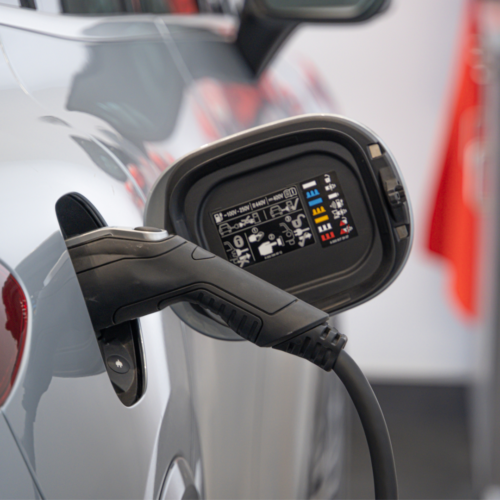Despite progress with the advancement of technology and electric vehicles, property management, building owners, and firefighters are faced with the challenge of EV fires in parking structures. Given the enclosed environment, and close proximity to other vehicles and property, effectively preparing buildings, systems, and people for EV fires is a necessity. There are several factors to consider in preparing for the potential of an EV fire. In this article, we will review the nature of lithium-ion battery (LIB) fires, codes, construction, and the risks involved.
Why does it matter?
There is currently no national database in Canada tracking the number of EV-related fires. There have been instances of fires in parking garages attributed to EV or LIB-related fires. In other cases, the source of the fire was different, such as a 2018 parking structure near Victoria Park and Eglington Avenue in Toronto that was attributed to careless smoking. Regardless of where the fire started, when EVs are present, firefighters will face significant challenges in extinguishing an EV that is on fire. These include:
· The large amounts of water required to extinguish the fire.
· Risk of electrocution due to the stranded energy in lithium-ion batteries.
· Accessibility to the batteries.
· Release of toxic gases.
Furthermore, the spontaneity of combustion in EVs has resulted in insurance and tenant rights issues and, in some cases, the banning of EV parking in both above-grade and underground garages. For one Toronto apartment complex, this included EVs, electric bikes and motorbikes, hoverboards, mopeds, Segways, and skateboard scooters.
Why are LIB fires so dangerous in parking structures?
When parked, particularly in places of residence or work, EVs are plugged in to charge. A study by the National Research Council of Canada reports that “over a third of all EV fires happen while connected to energized alternating current or direct current charging stations, or within 1 hour of being disconnected, indicating that there may be a greater risk of a fire during EV charging.”
Once ignited, the spread of fire to other vehicles nearby is very quick. Testing of multiple modern vehicles has shown it can take only 10-20 minutes for a fire to spread from an EV. Because LIBs already contain the fuel and oxygen elements, these can react together to create a “thermal runaway” effect causing the fire to burn much longer than an ICE vehicle and possess a high potential for re-ignition. The temperatures of EV fires can be three times higher than those of gas and diesel vehicles. Not only can these fires occur spontaneously on their own, but even if the origin of the fire was elsewhere, once an EV vehicle is involved, the consequences are multiplied.
As firefighters work to suppress the fire, they are challenged with reaching seemingly inaccessible onboard batteries. As we recently learned in our Apply and Comply: A Firefighter’s Perspective, testing is underway to find the best way to address this problem. Currently, EVs must be jacked up to provide access to the battery underneath the car. When a LIB cannot be sufficiently cooled by a fire suppressant, it has a high potential to reignite. Consequently, depending on where the location of the EV is in the parking structure and the ability to remove it from the parking structure promptly, it poses a further risk even after the fire is determined to be extinguished.
Codes and Construction
The current fire safety regulations and standards for parking structures have mostly been based on internal combustion engines (ICE). Because the current codes are older, they assumed a low level of fire risk for parking garages, or at least that firefighters would be able to extinguish a single vehicle before the fire had a chance to spread to others. Consequently, there were nominal requirements for sprinkler or detection systems. Originally, the basic requirements for parking structures provide (1) fire resistance, which is specified as a time to failure under a standardized fire test, and (2) requirements for sprinkler protection.
As the experience of EV fires has proven, these fires can move fast. The subsequent concrete and rebar deterioration from the fire, heat, and water can pose a great risk to a building’s structural integrity. The NRCC study reports:
“Joyeux et al. showed that there is no structural collapse if the fire does not spread beyond 3-4 vehicles [13]. Therefore, early detection and suppression are crucial for fire protection of parking structures with modern vehicles.”
The study cites the following codes and standards that are addressing EV fires:
International Building Code (IBC) 2021– Section 406.2.7 recommends the installation of EV charging stations and systems according to NFPA 70 (American National Electric Code) with the equipment listed and labeled in accordance with UL 2202 (Standard for EV Charging System Equipment) and the EV supply equipment listed and labeled as per UL 2594.
The National Building Code (NBC) of Canada – the basic design of parking structures is based on the requirements of CSA S413 and NFPA 88A is adopted for the fire protection requirements.
NFPA 70 developed standards to address the growth in EV charging stations.
The recent 2023 edition of NFPA 88A, Standard for Parking Structures, (6.4.2) now includes a provision for all garages, open and enclosed, to have sprinkler protection.
- According to the standard, only those parts of parking structures located within 3 m from another occupancy for any other purpose shall be separated by walls of fire resistance rating not less than 2 hrs according to ASTM E119 or UL 263. This rating can be reduced to 1 hour if the parking structure is protected throughout by sprinklers. Floors should be of non-combustible, and sprinklers should be installed in all parking structures. The exterior sides in open parking structures should have uniformly distributed openings on 2 or more sides with total area 20% of the total perimeter wall area to provide natural ventilation.
- It also mandated the development of an emergency plan for the parking structures, ventilation of all enclosed parking structures by a mechanical system capable of providing a minimum of 300 L/min per m2 of floor area during normal operating hours and the installation of an automatic sprinkler system in all types of parking structures.
Preparation and Mitigation
Beyond code compliance, mitigation efforts should include secure access to water supply from which hoses can reach all parts of the garage, fire blankets, and battery extinguishing systems. Sprinklers alone will not be able to extinguish LIB fires, however, they will be able to prevent the spread of fire. Ventilation and smoke management systems should be examined, updated, and maintained. Early detection systems, such as the SmokeCatcher system, should be deployed. Fire Safety Plans, Fire Warden Training, and Building Operator Training should all be current.
For more information on addressing code compliance and fire systems for your parking structure, contact us today.

